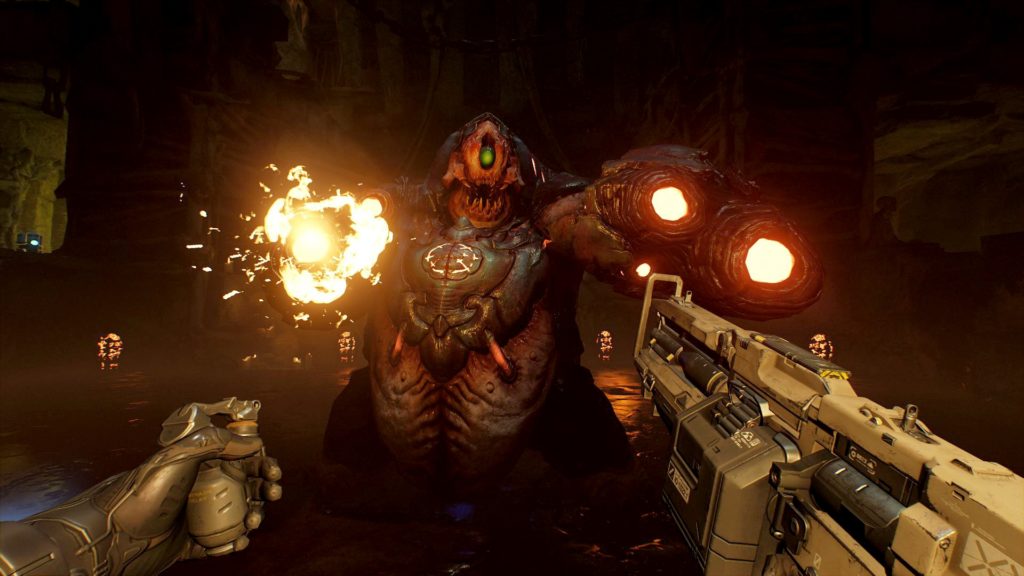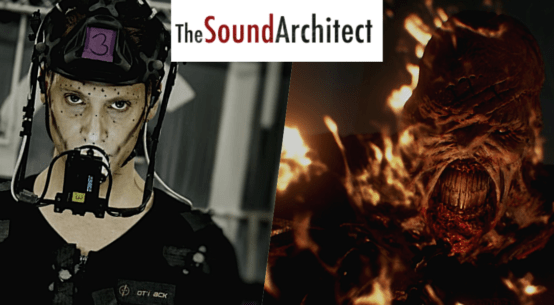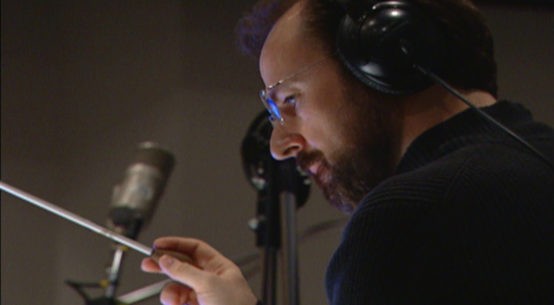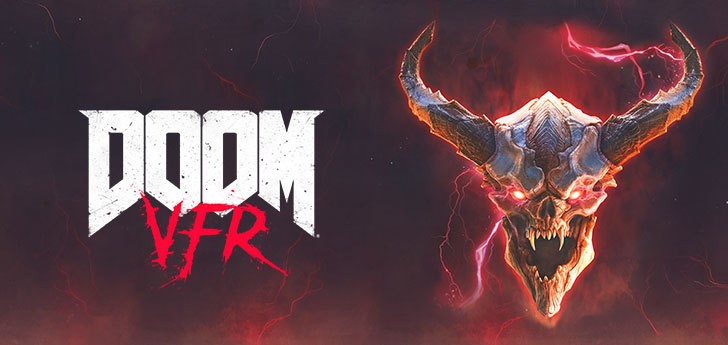
Review by Tom Garner
Edited by Alyx Jones
Developer: Bethesda Game Studios
Publisher: Bethesda Softworks
Composer: Mick Gordon
Audio Design: Ben Carney and Chad Mossholder
Reviewed on: PC
I fear I may start needing a disclaimer atop these reviews until I talk about a game that’s been designed specifically for VR, rather than games that are essentially VR ports. As with my Fallout 4 VR review, this one follows on from Matt Hellewell’s TSA review [link] of the original Doom (as in the original new Doom from 2016, not to be confused with the original 1993 Doom). As a result, there is a little overlap between the two reviews and I will forego the outline of what Doom is all about. You should know that by now…
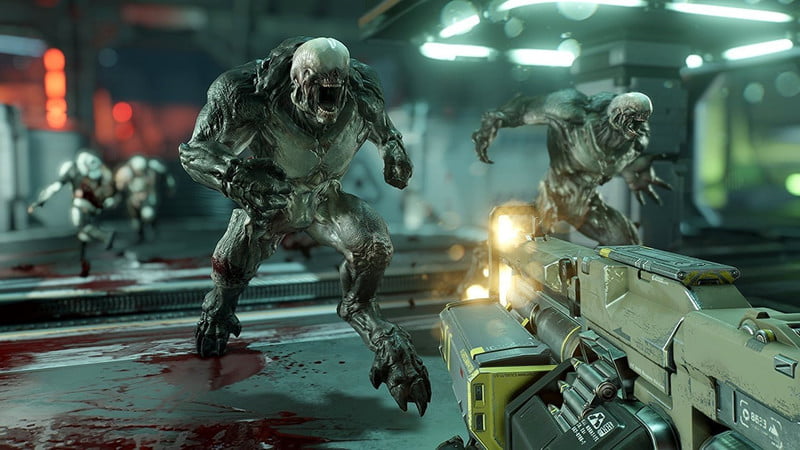
Facing off against a swarm of Hell Knights. Fun.
Comparing Doom VFR to Doom (FPS)
As a VR port, it seemed a sensible move to check if some of Matt’s observations of 2016’s Doom first-person shooter (I’m going to refer to the game as ‘non-VR Doom’ from here on out) carried over into Doom VFR. Starting with music, Mick Gordon’s score is as much ‘classic-Doom’ in Doom VFR as it is in non-VR, evoking the style and mood of the game brilliantly. The distorted-guitar-led music that plays when an arena battle commences is particularly evocative and great for raising the bloodlust. One problem with the music that carries over from non-VR to Doom VFR however is its constant playing throughout. Whilst there is a difference in tension between the calmer level-exploration sections and the intense arena battles, the exploration music is still too prominent in the mix – ultimately making the arena music less of a gut punch when it arrives.
One positive point in non-VR Doom that doesn’t transfer to Doom VFR is the way in which the stings and musical transitions are neatly synchronised to certain in-game actions. Of course, with teleportation for player-movement and the removal of the glory kill takedowns (replaced by tele-fragging, which we return to later) syncing music and action together seamlessly would be very difficult.
Two negative points in non-VR Doom that are improved upon in Doom VFR are the ambient environmental audio and the avatar movement sounds. As mentioned earlier, the music that plays during the calmer sections of gameplay is too high in the mix (assuming you have everything in your audio settings set to 100%). Turing the music down, or even off, reveals how much of the ambient sound has been obscured as the environments suddenly become much more immersive. Also, as the player moves around using teleportation there is no need for player-footstep sound. This removes an issue raised in Matt’s non-VR Doom review; that some footstep sounds (particularly upon sand) are overly prominent to the point of being distracting.
Lastly, Matt’s notes on non-VR Doom‘s weapon sounds are equally true in Doom VFR. Weapon sounds are not responsive to environmental acoustics and there is no bullet collision audio. That said, the general quality of the weapon sounds is very detailed and distinct, contributing to the great fun to be had whilst firing hot lead into the gaping mouths of those damn irritating Cacodemons.
Positional (3D) and environmental effects
In general, the 3D audio sometimes sounds a bit clunky, with not much transition between hard left and hard right panning. Player-character speech is well-balanced and sounds as if emanating from the player’s head. There are a couple of 3D sound gripes similar to those mentioned in our Fallout VR review, most notably the lack of 3D weapon sounds. Some of the foreground sounds that are positional however, work really well in VR, with sparking circuit boards and computer alarm beeps particularly responsive to the player’s head movements. One final little niggle is that occlusion effects seem pretty much absent and the loudness increase as an enemy approaches could be a little smoother (another issue also noted in the original Doom review).
The heavy machine gun is one of the most consistently satisfying in terms of sound. Maybe that’s why it keeps turning up in promotional screenshots.
VR interaction audio
As with the 3D and environmental sound, interaction/feedback audio is generally good but with a few issues. The main interface and HUD sounds are all present and correct whilst the slow-motion player-teleport action is accompanied by a pitch-bending/time-slowing of the audio. This is very effective and matches the action perfectly.
Now a word on ‘tele-fragging’ (I had to look this term up): A VR-unique action in which the player teleports themselves inside the body of a weakened enemy, then immediately busts out of them, sending entrails flying. When the player tele-frags, the resultant sound lacks the over the top quality to properly reflect the gloriously horrible thing you’re actually doing. Also, the interface sound that lets the player know they are able to tele-frag is also a little unintuitive, featuring a low, bouncy tone that players would normally associate with an ‘option not available’ or ‘access denied’ instruction.
As an FPS port, Doom VFR doesn’t include VR physics actions that are typical in bespoke VR games (e.g. picking objects up with your hands, and dropping or throwing things around). Weapons, health, order clonazepam online uk ammunition are all collected automatically once the player is close enough, rather than being something that can be physically picked up via the hand controllers. As manual pickup is something we’ve come to expect from VR-shooters (Superhot VR, Arizona Sunshine, etc.), automatic pickups like this require clear audio cues. Whilst these cues in the game are clearly audible, they’re generally too similar, making it difficult to know immediately what it is that you’ve just picked up.
General audio qualities
As an arena-shooter, it is understandable that the priority for Doom VFR, like Doom, was to create a chaotic soundscape that induced: panic in the noob, and bloodlust in the pro. Having said that, a clearer sonic profile of the major enemy classes would have helped. Different enemy classes require different approaches to take them down effectively, but often enemies teleport into the arena from outside the player’s field of view. The result is that you often don’t know what’s trying to eat your flesh (pound your head into the ground, burn you alive, melt you down into a pile of goo, etc.) until that creature is right on top of you.
As with the absence of footsteps, Doom VFR pretty much avoids avatar sounds altogether, with no discernible grunts, breathing or pain sounds when the player is injured. Such sounds are typically used to raise tension in horror games and their absence reinforces the direction of Doom VFR as being very much about the action and not about the frights.
Overall, the audio of Doom VFR reflects the game as all-action, zero-horror. If you’re in the market for a pure horror VR experience, try Layers of Fear: Solitude. If you’d prefer a balance of action and horror, consider Resident Evil VII. If however, you’re after a sci-fi horror aesthetic that you can fill to the brim with bullets, plasma blasts and many bits of demon brain, Doom VFR should suit you nicely and its audio is certainly fit for this purpose.
LINKS
Official
We hope you enjoyed Tom’s review, check out others in our Reviews section. Don’t forget to sign up to our Monthly Newsletter to make sure you don’t miss out on our reviews and interviews.
We’re also running a Patreon campaign to make sure we can keep bringing you regular, high quality content if you’re feeling generous! Thanks for even sharing!
The Sound Architect


